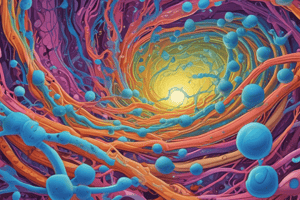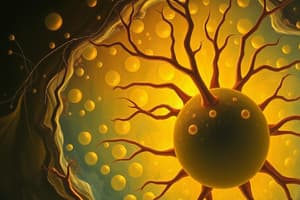Podcast
Questions and Answers
What is the typical resting membrane potential of a neuron?
What is the typical resting membrane potential of a neuron?
- +30 mV
- -55 mV
- -70 mV (correct)
- 0 mV
An action potential is initiated when the membrane potential reaches a threshold of approximately -90 mV.
An action potential is initiated when the membrane potential reaches a threshold of approximately -90 mV.
False (B)
What type of ion channels open in response to the binding of a specific neurotransmitter?
What type of ion channels open in response to the binding of a specific neurotransmitter?
Ligand-gated ion channels
The period after an action potential during which another action potential cannot be generated is called the ______ period.
The period after an action potential during which another action potential cannot be generated is called the ______ period.
Match the following terms with their descriptions:
Match the following terms with their descriptions:
Which of the following best describes the role of myelin in action potential propagation?
Which of the following best describes the role of myelin in action potential propagation?
Electrical synapses involve the release of neurotransmitters into the synaptic cleft.
Electrical synapses involve the release of neurotransmitters into the synaptic cleft.
What ion is primarily responsible for triggering the fusion of neurotransmitter-containing vesicles with the presynaptic membrane?
What ion is primarily responsible for triggering the fusion of neurotransmitter-containing vesicles with the presynaptic membrane?
Receptors that mediate fast postsynaptic responses by directly opening or closing ion channels are known as ______ receptors.
Receptors that mediate fast postsynaptic responses by directly opening or closing ion channels are known as ______ receptors.
Match the following neurotransmitters with their primary effect on the postsynaptic membrane:
Match the following neurotransmitters with their primary effect on the postsynaptic membrane:
Which of the following is NOT a mechanism for removing neurotransmitters from the synaptic cleft?
Which of the following is NOT a mechanism for removing neurotransmitters from the synaptic cleft?
Sensory transduction involves converting electrical signals into stimulus energy.
Sensory transduction involves converting electrical signals into stimulus energy.
What type of sensory receptor is responsible for detecting touch and pressure?
What type of sensory receptor is responsible for detecting touch and pressure?
[Blank] are photoreceptors in the retina that are sensitive to low light levels and responsible for night vision.
[Blank] are photoreceptors in the retina that are sensitive to low light levels and responsible for night vision.
Match the following sensory systems with the type of energy they detect:
Match the following sensory systems with the type of energy they detect:
Which brain region is primarily responsible for planning and initiating voluntary movements?
Which brain region is primarily responsible for planning and initiating voluntary movements?
Acetylcholine is the neurotransmitter released at the neuromuscular junction.
Acetylcholine is the neurotransmitter released at the neuromuscular junction.
What is the term for the long-lasting increase in synaptic strength that is thought to be a cellular mechanism of learning and memory?
What is the term for the long-lasting increase in synaptic strength that is thought to be a cellular mechanism of learning and memory?
The ______ is a brain region critical for the formation of new declarative memories (memories for facts and events).
The ______ is a brain region critical for the formation of new declarative memories (memories for facts and events).
Match the following brain regions with their primary cognitive functions:
Match the following brain regions with their primary cognitive functions:
Flashcards
Neurophysiology
Neurophysiology
The study of the function of the nervous system, incorporating biophysics, molecular biology, and anatomy.
Electrical and Chemical Signals
Electrical and Chemical Signals
Neurons communicate using these types of signals.
Resting Membrane Potential
Resting Membrane Potential
The typical electrical potential across a neuron's membrane when it is not actively signaling.
Ion Channels
Ion Channels
Signup and view all the flashcards
Voltage-Gated Ion Channels
Voltage-Gated Ion Channels
Signup and view all the flashcards
Action Potentials
Action Potentials
Signup and view all the flashcards
Depolarization
Depolarization
Signup and view all the flashcards
Repolarization
Repolarization
Signup and view all the flashcards
Refractory Period
Refractory Period
Signup and view all the flashcards
Myelination
Myelination
Signup and view all the flashcards
Synapses
Synapses
Signup and view all the flashcards
Chemical Synapses
Chemical Synapses
Signup and view all the flashcards
Ionotropic Receptors
Ionotropic Receptors
Signup and view all the flashcards
Metabotropic Receptors
Metabotropic Receptors
Signup and view all the flashcards
Excitatory Neurotransmitters
Excitatory Neurotransmitters
Signup and view all the flashcards
Synaptic Integration
Synaptic Integration
Signup and view all the flashcards
Sensory Receptors
Sensory Receptors
Signup and view all the flashcards
Mechanoreceptors
Mechanoreceptors
Signup and view all the flashcards
Neuromuscular Junction
Neuromuscular Junction
Signup and view all the flashcards
Long-Term Potentiation (LTP)
Long-Term Potentiation (LTP)
Signup and view all the flashcards
Study Notes
- Neurophysiology is the study of the function of the nervous system
- It incorporates techniques from fields like biophysics, molecular biology, and anatomy to understand how the nervous system works
- Its scope ranges from studying single ion channels to cognitive functions
Cellular Neurophysiology
- Neurons communicate through electrical and chemical signals
- Electrical signals are based on changes in the neuron's membrane potential
- The resting membrane potential is typically around -70 mV
- This potential is maintained by ion gradients and selective permeability of the membrane to ions like sodium (Na+) and potassium (K+)
- Ion channels are transmembrane proteins that allow specific ions to pass through the membrane
- Voltage-gated ion channels open or close in response to changes in membrane potential
- Ligand-gated ion channels open or close in response to the binding of a specific neurotransmitter or other molecule
- Action potentials are rapid, transient changes in membrane potential that propagate along the neuron's axon
- An action potential is initiated when the membrane potential reaches a threshold, typically around -55 mV
- Depolarization occurs as Na+ channels open, allowing Na+ to flow into the cell and making the membrane potential more positive
- Repolarization occurs as Na+ channels inactivate and K+ channels open, allowing K+ to flow out of the cell and restoring the negative membrane potential
- Hyperpolarization may occur due to the prolonged opening of K+ channels, making the membrane potential more negative than the resting potential
- The refractory period is a period after an action potential during which another action potential cannot be generated (absolute refractory period) or requires a stronger stimulus (relative refractory period)
- Myelination increases the speed of action potential propagation
- Action potentials "jump" between the Nodes of Ranvier, which contain a high concentration of voltage-gated Na+ channels; this is called saltatory conduction
Synaptic Transmission
- Synapses are specialized junctions through which neurons communicate with each other or with target cells like muscle or gland cells
- Electrical synapses involve direct electrical coupling between cells through gap junctions, allowing for very fast transmission
- Chemical synapses involve the release of neurotransmitters from the presynaptic neuron
- When an action potential reaches the presynaptic terminal, voltage-gated Ca2+ channels open, allowing Ca2+ to enter the cell
- Influx of Ca2+ triggers the fusion of neurotransmitter-containing vesicles with the presynaptic membrane, releasing neurotransmitter into the synaptic cleft
- Neurotransmitters diffuse across the synaptic cleft and bind to receptors on the postsynaptic membrane
- Neurotransmitter receptors can be ionotropic receptors (ligand-gated ion channels) or metabotropic receptors (G protein-coupled receptors)
- Ionotropic receptors mediate fast postsynaptic responses by directly opening or closing ion channels
- Metabotropic receptors activate intracellular signaling pathways that can modulate ion channels or other cellular processes, leading to slower but longer-lasting postsynaptic effects
- Excitatory neurotransmitters (e.g., glutamate) cause depolarization of the postsynaptic membrane, leading to an excitatory postsynaptic potential (EPSP)
- Inhibitory neurotransmitters (e.g., GABA, glycine) cause hyperpolarization or stabilization of the postsynaptic membrane, leading to an inhibitory postsynaptic potential (IPSP)
- Postsynaptic potentials are graded potentials, meaning their amplitude depends on the amount of neurotransmitter released and the number of receptors activated
- Synaptic integration is the process by which postsynaptic potentials are summed to determine whether the postsynaptic neuron will fire an action potential
- Neurotransmitters are removed from the synaptic cleft by diffusion, enzymatic degradation, or reuptake into the presynaptic terminal or glial cells
Sensory Neurophysiology
- Sensory systems detect and process information from the environment
- Sensory receptors are specialized cells that transduce different forms of energy (e.g., light, sound, pressure, chemicals) into electrical signals
- Sensory transduction involves converting the stimulus energy into a change in membrane potential
- Receptor potentials are graded potentials that are produced in response to sensory stimuli
- Sensory neurons encode information about the intensity, duration, and location of the stimulus
- Different sensory modalities (e.g., vision, hearing, touch) are processed in different brain regions
- Somatosensory system detects touch, temperature, pain, and proprioception
- Mechanoreceptors detect touch and pressure
- Thermoreceptors detect temperature changes
- Nociceptors detect pain
- Proprioceptors detect body position and movement
- Visual system detects light
- Photoreceptors (rods and cones) in the retina transduce light into electrical signals
- Rods are sensitive to low light levels and are responsible for night vision
- Cones are responsible for color vision and require higher light levels
- Auditory system detects sound
- Hair cells in the cochlea transduce sound vibrations into electrical signals
- Vestibular system detects head position and movement
- Hair cells in the vestibular organs transduce head movements into electrical signals
- Olfactory system detects odors
- Olfactory receptor neurons in the nasal epithelium detect odor molecules
- Gustatory system detects tastes
- Taste receptor cells in taste buds detect taste molecules
Motor Neurophysiology
- Motor systems control movement
- The motor system involves a hierarchy of brain regions, including the motor cortex, basal ganglia, cerebellum, and brainstem
- The motor cortex plans and initiates voluntary movements
- The basal ganglia are involved in the selection and initiation of movements
- The cerebellum coordinates movements and maintains balance
- The brainstem contains motor nuclei that control basic motor functions
- Upper motor neurons in the motor cortex project to lower motor neurons in the brainstem and spinal cord
- Lower motor neurons directly innervate muscles
- The neuromuscular junction is the synapse between a motor neuron and a muscle fiber
- Acetylcholine is the neurotransmitter released at the neuromuscular junction
- Muscle contraction is initiated by the binding of acetylcholine to receptors on the muscle fiber, leading to depolarization and the release of calcium ions
Higher-Order Neurophysiology
- Cognitive neurophysiology studies the neural basis of cognitive functions such as learning, memory, attention, and decision-making
- Learning is the process by which experiences change the nervous system and behavior
- Memory is the ability to store and retrieve information
- Long-term potentiation (LTP) is a long-lasting increase in synaptic strength that is thought to be a cellular mechanism of learning and memory
- Long-term depression (LTD) is a long-lasting decrease in synaptic strength
- The hippocampus is a brain region that is critical for the formation of new declarative memories (memories for facts and events)
- The amygdala is a brain region that is involved in processing emotions, particularly fear
- Attention is the process of selectively focusing on certain information while ignoring other information
- Decision-making is the process of selecting a course of action from a set of alternatives
- The prefrontal cortex is a brain region that is involved in executive functions such as planning, working memory, and decision-making
Studying That Suits You
Use AI to generate personalized quizzes and flashcards to suit your learning preferences.




